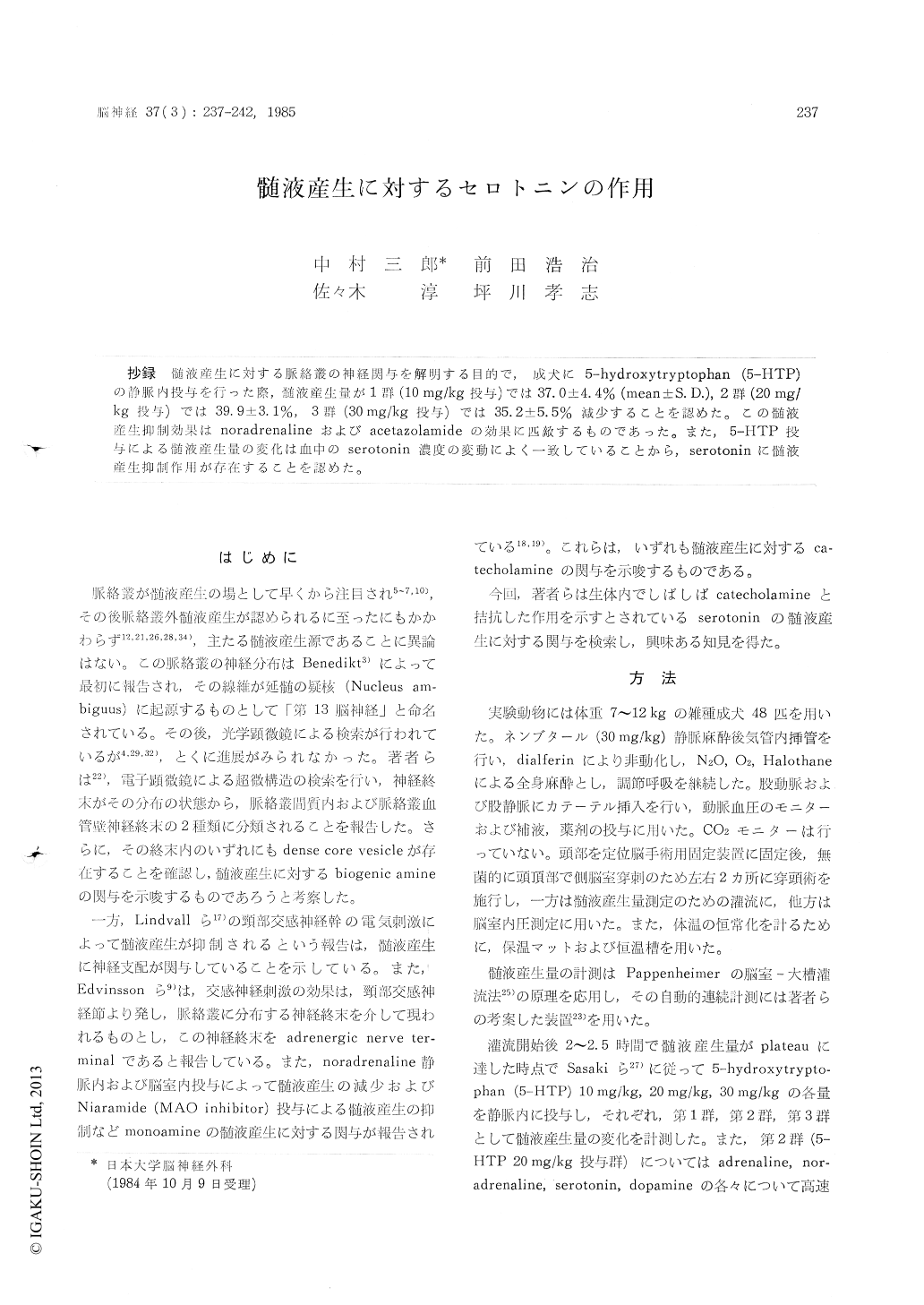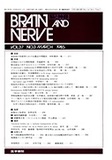Japanese
English
- 有料閲覧
- Abstract 文献概要
- 1ページ目 Look Inside
抄録 髄液産生に対する脈絡叢の神経関与を解明する目的で,成犬に5—hydroxytryptophan (5—HTP)の静脈内投与を行った際,髄液産生量が1群(10mg/kg投与)では37.0±4.4%(mean±S.D.),2群(20 mg/kg投与)では39.9土3.1%,3群(30mg/kg投与)では35.2±5.5%減少することを認めた。この髄液産生抑制効果はnoradrenalineおよびacetazolamideの効果に匹敵するものであった。また,5—HTP投与による髄液産生量の変化は血中のserotonin濃度の変動によく一致していることから,serotoninに髄液産生抑制作用が存在することを認めた。
Many details concerning CSF production at the choroid plexus remain unsettled, and the control mechanisms on the production are also not yetclarified. In the present study, the association of serotonin in the dynamics of the CSF production was studied.
The authors utilized the ventriculocisternal per-fusion method developed by Pappenheimer and an automatic continuous measurement technique which was deviced by the authors. The experimentalanimals comprised 48 mongreal dogs weighing 7.0 to 12.0 kg. The animals were inactivated by in-travenous injection of Dialferin't after intratra-cheal intubation for generalized anesthesia with N20, 02 and HalothaneR.
Within about 2-2.5 hours after starting perfu-sion of the Blue Dextran-Elliott-β perfusion fluid, the optical density reached a plateau, and the CSF production in the control dogs could be cal-culated. Once the data for the control had been obtained, intravenous administration of 5-hydro-xytryptophan (5-HTP), noradrenaline (NA) and acetazolamide (DiamoxR) was commenced.
Administration of various amount of 5-HTP, a precursor of serotonin, reduced the CSF produc-tion, that was, after administration of 10 mg/kg, 20 mg/kg, and 30 mg/kg 5-HTP the CSF produc-tion reduced by 37.0 ± 4.4%, 39.9 ± 3.1%, and 35.2 ±5.5% (mean±SD), respectively, and no correla-tion with dose was observed.
After administration of 5-HTP, the blood pres-sure showed unsteady state for about 10 minutes, showing an increase in pulse pressure. It then declined gradually. All these phenomena were within the range of autoregulation.
Intravenous drop infusion of noradrenaline (10-7 M) was continued, and, while monitoring blood pressure, the systolic pressure was controlled so as to maintain it at 160-180 mmHg. After admi-nistration, a decrease in CSF production of 13.8± 4.2% was observed.
After administration of 50 mg/kg and 100 mg/kg DiamoxR, the CSF production decreased by 28.5 ±3.6%, and 57.2 ±7.0%, respectively.
Examination of the blood concentrations of adrenaline, noradrenaline and serotonin revealed the well-corresponding changes of CSF production with that of serotnin rather than adrenaline and noradrenaline after administration of 5-HTP. From these facts the serotonergic reducing effect on CSF production is proposed and the existence of serotonergic receptors, furthermore, serotonergic neuron is suggested. The serotonergic reducing effect corresponds to that of noradrenaline and of acetazolamide.
The reducing mechanism of serotonin has not been clarified, however, the similar mechanism as that of noradrenaline which has been reported to reduce the carbonic anhydrase activity in the choroid plexus, is supposed.

Copyright © 1985, Igaku-Shoin Ltd. All rights reserved.


